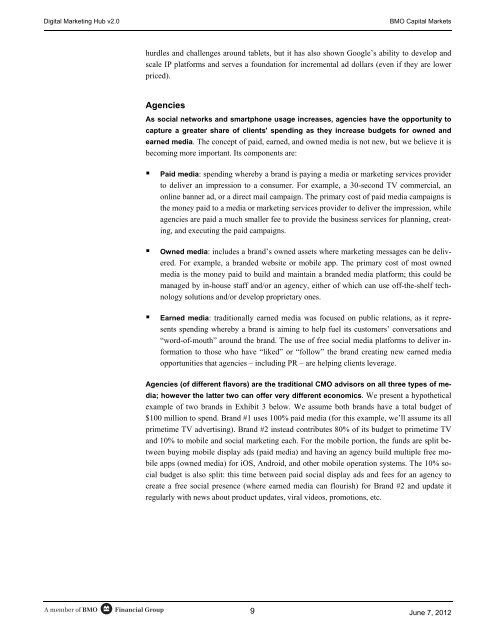DIGITAL MARKETING HUB v2.0 - AdExchanger
DIGITAL MARKETING HUB v2.0 - AdExchanger
DIGITAL MARKETING HUB v2.0 - AdExchanger
Create successful ePaper yourself
Turn your PDF publications into a flip-book with our unique Google optimized e-Paper software.
Digital Marketing Hub <strong>v2.0</strong><br />
BMO Capital Markets<br />
hurdles and challenges around tablets, but it has also shown Google’s ability to develop and<br />
scale IP platforms and serves a foundation for incremental ad dollars (even if they are lower<br />
priced).<br />
Agencies<br />
As social networks and smartphone usage increases, agencies have the opportunity to<br />
capture a greater share of clients' spending as they increase budgets for owned and<br />
earned media. The concept of paid, earned, and owned media is not new, but we believe it is<br />
becoming more important. Its components are:<br />
• Paid media: spending whereby a brand is paying a media or marketing services provider<br />
to deliver an impression to a consumer. For example, a 30-second TV commercial, an<br />
online banner ad, or a direct mail campaign. The primary cost of paid media campaigns is<br />
the money paid to a media or marketing services provider to deliver the impression, while<br />
agencies are paid a much smaller fee to provide the business services for planning, creating,<br />
and executing the paid campaigns.<br />
• Owned media: includes a brand’s owned assets where marketing messages can be delivered.<br />
For example, a branded website or mobile app. The primary cost of most owned<br />
media is the money paid to build and maintain a branded media platform; this could be<br />
managed by in-house staff and/or an agency, either of which can use off-the-shelf technology<br />
solutions and/or develop proprietary ones.<br />
• Earned media: traditionally earned media was focused on public relations, as it represents<br />
spending whereby a brand is aiming to help fuel its customers’ conversations and<br />
“word-of-mouth” around the brand. The use of free social media platforms to deliver information<br />
to those who have “liked” or “follow” the brand creating new earned media<br />
opportunities that agencies – including PR – are helping clients leverage.<br />
Agencies (of different flavors) are the traditional CMO advisors on all three types of media;<br />
however the latter two can offer very different economics. We present a hypothetical<br />
example of two brands in Exhibit 3 below. We assume both brands have a total budget of<br />
$100 million to spend. Brand #1 uses 100% paid media (for this example, we’ll assume its all<br />
primetime TV advertising). Brand #2 instead contributes 80% of its budget to primetime TV<br />
and 10% to mobile and social marketing each. For the mobile portion, the funds are split between<br />
buying mobile display ads (paid media) and having an agency build multiple free mobile<br />
apps (owned media) for iOS, Android, and other mobile operation systems. The 10% social<br />
budget is also split: this time between paid social display ads and fees for an agency to<br />
create a free social presence (where earned media can flourish) for Brand #2 and update it<br />
regularly with news about product updates, viral videos, promotions, etc.<br />
A member of BMO<br />
Financial Group<br />
9<br />
June 7, 2012


